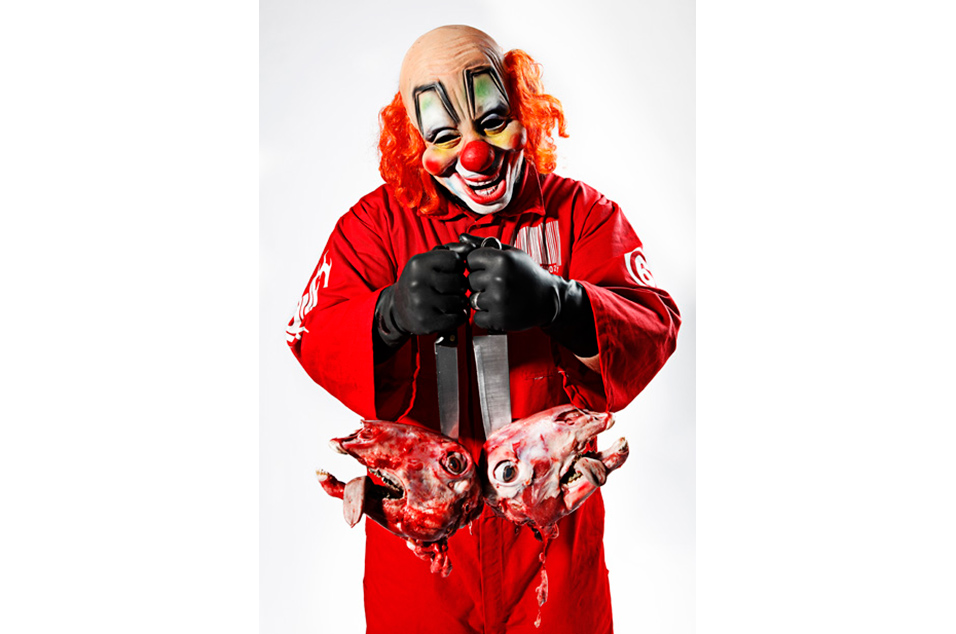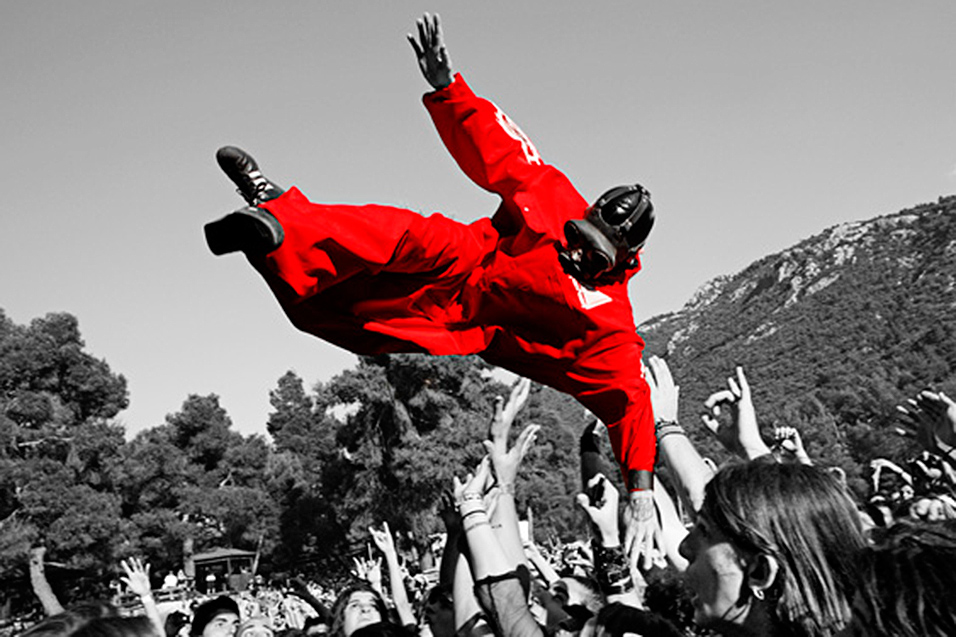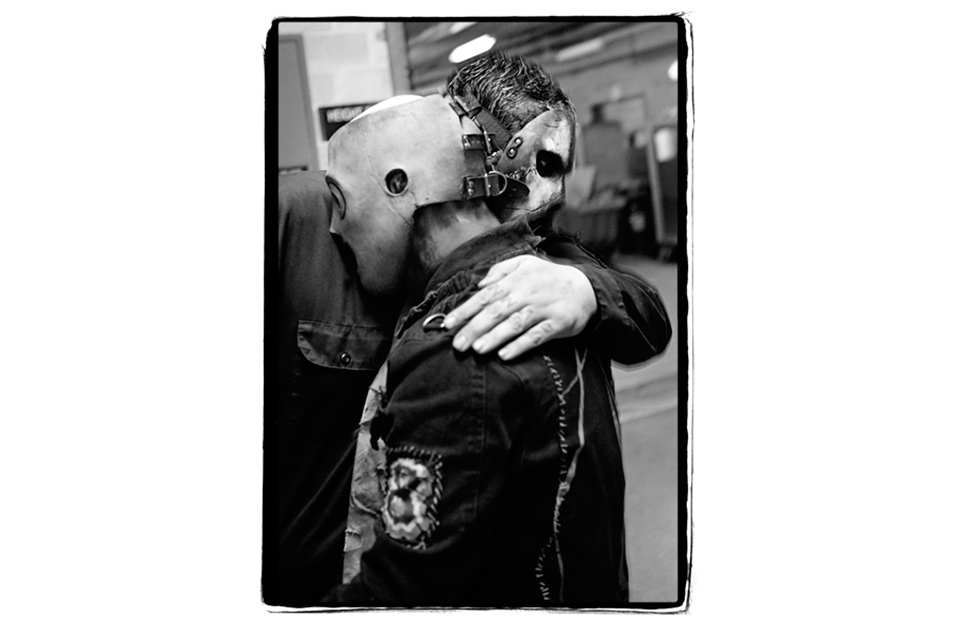Since they first arrived quite literally kicking and screaming on the metal scene in 1998, love them or loathe them, Slipknot have created one of the most easily recognisable visual identities in music. It’s a nightmarish, uncompromising aesthetic that’s evolved with each of their five albums to date, but carries the same air of absurdity and horror each time. Gnarled circus masks. Industrial boiler suits, gritted with grime, slathered in dirt. Sepia-hued album covers and music videos the colour of the brine at the bottom of a drain. It’s impact is polarizing but undeniable: show your poor old aunt a photo of Corey Taylor bearing down on a camera lens and chances are she’d be able to name the band he fronts, if only from the countless Daily Mail moral panics their menacing look has earned them over the years.
Documenting and arguably contributing to that aesthetic over the last 15 years has been photographer Paul Harries. With essentially unrivalled access to the band, he’s been there intermittently through the bulk of their career and in his new book Slipknot: Dysfunctional Family Portraits he compiles a decade and a half of photos into a candid and often shocking visual trip into the belly of a beast that, fast approaching 20 years since their emergence from Des Moines, Iowa, continue to baffle and bewitch the world of music.

Having started shooting professionally in 1989, working predominantly for weekly music papers, Harries cut his teeth with an array of high profile bands. Notably, his early career saw him shoot Nirvana at their now legendary 1991 gig at London’s sadly defunct Astoria. “They were a bit strange to be honest,” remembers Harries of the event. “It was on the cusp of the band really taking off and there was a real buzz about them, but it hadn’t quite got as big as it would. Kurt was weird that day; he didn’t want to look at the camera.”
Across the years, Harries continued to work with everyone from Metallica to Green Day, but it was Slipknot that really captured his imagination. “I’d shot bands that wear masks before and they always end up being a bit rubbish but this was like, ‘oh my god’. It looked really creepy, they had the red boiler suits on and the masks looked really homemade in a threatening way. It was so much better than what I’d seen before,” he says. “It’s just theatrical, I always like shooting bands that have that visual element to them and this is probably the ultimate.”

Throughout his time shooting the band, it’s fair to say that there’s been more than a hefty dose of theatricality involved. Take a brief flick through Dysfunctional Family Portraits and you’ll find blood and gore galore. The extreme image below, for example, was taken in 2011 on tour. Harries remembers: “It was on the 10 year anniversary of the band’s album ‘Iowa’. That album has a goat on the cover so they wanted the shoot done with goat’s head. He had a bag full of them and they were horrible, their tongues kept falling out of their mouths and then he wanted the eyes gouged out. As long as no one was getting hurt then I’d shoot anything they wanted to do.”
Recommended

Other experiences were equally crazy, such as the video shoot for 2004 track ‘Duality’ that he went along to document. “In the video, there’s about 300 kids who crash through this derelict house and they’re surrounding the band, smashing through windows and walls. I don’t think they were expecting the house to get as wrecked as it did. I was in the basement at one point and was told to get out cos they weren’t sure if the floor was going to collapse.”
And within these episodes of staged insanity, there were also bouts of real life craziness. Slipknot’s fans, he states, can be unsurprisingly extreme in their ardor. “There was one time when a guy brought a glass jar with dead chicks in it, gave it to the Clown (real name Shawn Crahan), said nothing and walked off. They embrace it really; they’re used to crazy people,” says Harries. Meanwhile, though he concedes that “some live their [onstage] character more than others”, there are still baffling incidences within Camp Slipknot itself. “Sid the DJ is crazy; he’s always hurting himself,” he laughs. “There’s a picture in my book of him in a wheelchair on stage because he’d jumped off something, broken both of his heels – apparently they’re like eggshells – and just carried on. He was dragging himself round the stage because he couldn’t walk.”

More surprising than any of these eye-opening antics, however, are the photos in his book that show a softer side to Slipknot. There is one image entitled ‘Brothers’ (below) that depicts singer Corey Taylor and former bassist Paul Gray, who died in 2010 of an accidental morphine overdose, in an embrace. It’s a candid and touching image of a band that have gone to great lengths to literally mask their human side. “It was an image I’d overlooked before, but then when he died I had a look back and found it. They are a real family – a weird family, but very much a family.”

Harries has spent more time with Slipknot, gaining their trust and slowly documenting their inimitable production, than anyone and Dysfunctional Family Portraits is the culmination of these 15 years. “Other bands have their own look, but Slipknot push that to the maximum,” he concludes. “I start shooting them and I don’t want to stop.”
